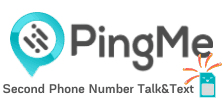USA — Number OTP Features & Restrictions
Last updated: September 10, 2025
Optimize Your Verification Now!
Secure a second number for registration and verification across platforms.
Optimize Your Verification Now!
Secure a second number for registration and verification across platforms.
Want a discount?
For new users only, download PingMe now to get $0.2 free credit towards receiving your verification code.
Quick Facts
- Dial: +1 MCCs: multiple (AT&T, T-Mobile, Verizon, etc.).
- Sender types for OTP: 10DLC local numbers, Toll-Free (8xx), Short Codes. Alphanumeric Sender ID is not supported in the US/CA.
What works best for OTP in the US
- 10DLC (local 10-digit numbers) — Mandatory brand + campaign registration via The Campaign Registry (TCR); 2FA/OTP is a standard campaign use case. Unregistered traffic is broadly blocked as of 2024/2025 enforcement. Throughput depends on brand/campaign vetting & trust scores.
- Toll-Free — Verification is required for US/CA; unverified TFN traffic is blocked. Suitable for OTP & customer care.
- Short Code (5–6 digits) — Highest throughput/reliability; needs full CTIA/carrier approval and weeks of lead time. Best for very high-scale OTP.
- Alphanumeric Sender ID — Not available in the US/CA (use 10DLC/Toll-Free/Short Code instead).
Compliance & content rules you must meet (even for OTP)
- Opt-in/consent & disclosures (STOP/HELP, message frequency, T&C/Privacy URL) per CTIA Messaging Principles and short-code standards. OTP generally qualifies as transactional user-initiated traffic, but your campaign still needs compliant flows.
- Prohibited content (SHAFT, illegal/illicit) and carrier code-of-conduct violations can trigger fines/blocks (e.g., T-Mobile enforcement).
“Receiving a code” to US numbers — what to expect
- Some apps block VoIP/virtual numbers for account verification (security/anti-abuse). This is common with major platforms; policies vary by app.
- Short code originators: delivery to virtual numbers depends on the provider; premium short codes are often unsupported. Check compatibility per app and number type.
PingMe products mapped to US OTP scenarios
- PingMe US numbers to receive OTP — “Second phone number” / “Receive SMS Online (USA)” pages list rotating US numbers to capture verification codes (temporary or disposable usage). Ideal when you need a one-off code to a US route.
- PingMe Verification Code Helper API — Programmatic access to get numbers and fetch inbound codes; useful for integrating OTP reception into your workflow/tools.
- PingMe “SMS Verification Code Helper” — Cataloged app targets & guidance on receiving verification messages (platform acceptance still depends on each app’s policy).
- Heads-up: If a target app blocks VoIP/virtual numbers, delivery can fail regardless of number freshness. Always test the specific app + number type before relying on it in production flows.
Registration & KYC at a glance (sending OTP to US users)
- 10DLC: Register Brand (EIN/Tax ID) + Campaign (use case “2FA/OTP”) in TCR; messages from unregistered 10DLC are filtered/blocked.
- Toll-Free: Submit Toll-Free Verification before sending; unverified traffic is blocked in US/CA.
- Short Code: Apply & pass CTIA/carrier vetting; expect weeks from submission to live.
-
Throughput & deliverability (sending)
- Throughput on 10DLC is assigned per brand/campaign/trust score; 2FA/OTP is a recognized campaign type. Registration generally reduces filtering and improves MPS.
- Toll-Free delivers well for OTP once verified; Short Codes deliver the highest scale/priority when you need massive volumes.
Common failure cases & fixes
- Unregistered 10DLC traffic blocked → Complete TCR brand + campaign; choose 2FA/OTP use case; ensure opt-in evidence.
- Toll-Free blocked → Submit Toll-Free Verification; wait for approval before load.
- Codes don’t arrive to a VoIP/virtual number → The app may disallow VoIP. Try a different route/number type or a SIM-based destination that app accepts.
- Content/flow non-compliant → Add STOP/HELP handling, clear disclosures, and avoid prohibited content.
Fast implementation checklist
If you need to receive OTP to a US number (research/testing, privacy use-cases):
-
- Grab a US number from PingMe (manual or API) → trigger verification → read inbound code. Note app policies may block VoIP.
If you need to send OTP to US users (your own customers):
-
- Pick a sender: 10DLC (most common), Toll-Free (verified), or Short Code (at scale).
- Register (10DLC: Brand+Campaign “2FA/OTP”; Toll-Free: Verification).
- Implement CTIA-compliant consent & keyword handling (STOP/HELP).
Source
- TCR (identity/registration rules).
- Twilio A2P 10DLC overview, campaign types, throughput, & approval requirements.
- CTIA Messaging Principles (2023) & Short Code Handbook (2024).
- Toll-Free verification (US/CA) — required; unverified blocked.
- Alphanumeric Sender ID not supported in US/CA.
- VoIP/virtual number acceptance varies by app (examples: WhatsApp restrictions; Riot’s SMS policy; general VoIP caveats).
- PingMe product pages & API docs (US numbers to receive OTP; Verification Code Helper API).
Ready to get your verification code?
Keep your primary number for those who matter. Using PingMe to get a verification code is fast, safe and secure.
First time users get a gift of $0.2 free credit to use towards getting a verification code.

